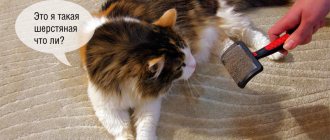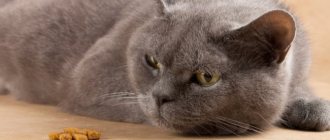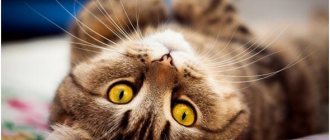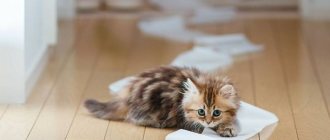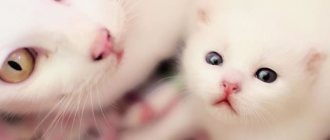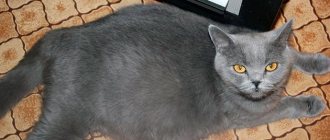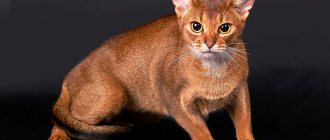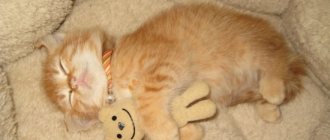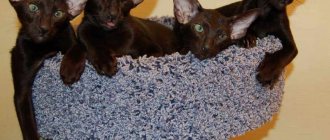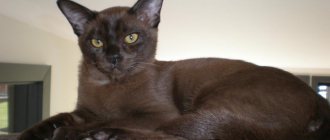Who doesn't love kittens? The kitten will never be as small and energetic as in the first months of life. Some may want their kitten to remain a tiny, playful ball of fluff, but a healthy cat will grow quite a bit during its first year of life.
If you find that your kitten is not developing as you expected, you may become concerned about why your cat is so small. Read on to find out what to do if you discover your kitten is too small for his age.
How much should a cat or kitten weigh?
Although cats don't vary in weight as much as dogs, they still have a wide range of "normal" weights. While the "average" cat weighs around 5kg at adult weight, cats can range from 2kg to 10kg and still be fit and healthy. This option mainly depends on the breed. However, among the "mixed breed" or "domestic shorthair" cats, they can still easily range from being thin but holding 2kg to being big-boned 7kg!
In other words, every cat is unique! So how can you tell if your kitten is growing normally or if your cat is just such a small problem?
© shutterstock
Choosing a place for a kitten's toilet
Cats try to satisfy their natural needs in an intimate environment, and the place chosen for the toilet in the apartment must meet a number of requirements:
- Availability. The kitten should be able to go to the litter box at any time.
- Privacy. Animals do not like to be looked at while they are emptying their bowels or bladder.
- Comfort. If the baby does not like the litter, then it is almost impossible to force him to go to the tray. It is recommended to take the pellets that were used by the breeder.
Familiar filler and a comfortable environment will allow the kitten to quickly get used to the new place.
How do I know if my kitten is growing?
The growing period is an important part of a cat's development. You can buy a baby scale and weigh her every day to track her growth on a graph. The curve connecting each point should be steep at first and then gradually level off as she reaches six months of age. As a guide, most kittens gain 100 grams of body weight per week until they are 6 months old.
Your veterinarian can also provide you with a kitten growth chart, which works like a baby growth chart. You can chart your kitten's growth and make sure he is within two percentiles of where he started. In other words, a small kitten should grow proportionately at the same rate as a large kitten, but it will eventually turn into a small cat. Likewise, a large kitten will follow the same growth curve and will eventually become a larger cat than an adult.
The average weight of a kitten usually follows the rule: about 450 grams for each month until 10 months of age. Keep in mind that males are usually larger than females. Other signs that your cat is growing properly are that she is interested in food, active during the day, and playful with other family members.
Smallest breed
There are not many cat breeds with small sizes in the world, so they are very expensive and in demand. In addition, small animals do not require special care, and their maintenance does not require large financial investments. But still, which breed is considered the smallest?
Considering all the small representatives of the cat family, it is worth stopping at one - Skif-tay-don. This is the smallest breed of cat, weighing barely one and a half kilograms. And some animals can weigh only 900 grams. They are similar in many ways to the Siamese because the latter are their main ancestors.
Nature has rewarded them with a sweet and bright appearance:
- Particular attention is drawn to short legs with neat dimensions. The tips of the paws are painted black;
- A black tint is present on the face, ears and tail;
- The tail of cats and cats is short, in appearance it seems that it is chopped off;
- Cats and male cats are compact in size; as adults they look like five-month-old kittens;
- Acceptable coat colors are color point or tortoiseshell;
- The animals' eyes are large and round in shape. The color is light blue.
Cats have a kind, friendly and peaceful character. They are able to find a common language with everyone - with people, children, and other pets. In addition, they are very inquisitive, they are interested in everything that happens around them.
Many people note that their character resembles that of ordinary dogs. Nature has endowed them with excellent devotion, which they show towards their owner. They rarely show aggression, only when there is danger.
How do you know if a cat is an adult?
The age at which a cat stops growing depends on the breed and their expected final size. For most cats this will be about a year. Larger breeds, such as the Maine Coon or Ragdoll, may take several years to grow to their adult size. You can get some clues about your own kitten's expected final weight by asking the breeder about the height of her siblings and parents.
© shutterstock
Kittens' growth slows down significantly at around 6 months of age or after neutering. While this isn't exactly their final weight, it will be close. At this stage, your cat will begin to gain excess weight in the form of fat rather than longer bones and muscles, so you will need to carefully monitor her diet. Your veterinary team will be able to help you determine when your kitten will reach adult body weight and discuss his diet.
Toys and other things for development and communication with a kitten
All children love to play, and felines are no exception. Having settled in a new place, the baby begins to enjoy running after a piece of paper on a string or chasing various objects across the floor.
It is better to make sure that the kitten has its own things:
- Movable toys. Fur balls, rubber mice and other similar things. It is important that toys do not have small parts: kittens are teething, the baby can bite off a small part and choke.
- Hanging objects. A ball hanging on a thread on the door handle will occupy the attention of a cat child for a long time.
- Scratching post. Sharpening claws is a natural need of the cat tribe. If you do not acquire this useful item, the furniture or carpet will suffer. In the first days, you need to show your pet a place where it is allowed to sharpen its claws.
A good option would be to purchase a special complex where your pet can climb and jump.
In addition to the fact that the device develops the cat's dexterity and flexibility, purchasing a device will reduce the likelihood that a playful baby will throw flowers from the windowsill or objects from the table.
What to do if your cat doesn't eat enough?
As long as your cat remains smart and playful without signs of illness, you can be sure that she is consuming enough calories to support her growth or maintenance. You can offer your kitten free access to food until 6 months of age.
As she grows beyond 6 months, it is recommended to measure her portions according to her daily needs. Excessive caloric intake in a kitten can cause early obesity, which is very difficult to treat later in life, so talk to your veterinarian about calculating your kitten's specific energy needs, which will depend on the kitten's activity level and spay/neuter.
When measuring your kitten's food, use a scale to maintain accuracy and avoid overeating. It's important to develop these healthy habits early on to ensure your kitten lives a long, healthy life.
Posted by Christian Adams An American expat living in Metro Manila, Philippines for over a decade, Christian is a lifelong cat lover and the proud father of two rescue cats, Trixie and Chloe. Both girls used to be among the crowds of homeless people who roam the cities and countryside. Three-year-old Trixie was rescued from a litter found under a neighbor's porch, and two-year-old Chloe was brought home by Christian's young son, Henry, who discovered the crying kitten in the parking lot.
Kitten nutrition
It is better to feed your baby on time, with even intervals between meals:
- up to 2 months – 5 times;
- by the age of six months, the frequency of feedings gradually decreases to 3 times, and the portion gradually increases;
- An eight-month-old animal is fed like an adult - twice a day.
Your pet's diet must include:
- raw beef;
- boiled chicken meat;
- milk porridge;
- egg yolk;
- raw and boiled vegetables;
- fermented milk products.
You cannot feed food from the human table: salt and spices are harmful to the cat’s body.
Veterinarians recommend purchasing balanced cat food for kittens, taking into account age. Specialized mixtures contain all the necessary elements necessary for the growth of a pet.
How to feed a kitten from birth to one year
Feeding kittens plays an important role in their development, their health depends on it. In the first 3 days after birth, kittens feed on maternal colostrum, then until about 2-2.5 months - cat's milk.
If for some reason the kitten is left without a mother, you should purchase a cat's milk substitute for it at a veterinary pharmacy. The kitten should be fed from a pipette, a syringe without a needle, or use a special bottle with a nipple. For the first four days, the kitten should receive food every two hours around the clock, then up to four weeks - every 4-6 hours. Prepare the mixture according to the manufacturer's instructions on the packaging.
Complementary feeding should be introduced to a kitten at the age of 1 month. You need to give special food for kittens, preferably premium or higher. Can be fed with natural food.
At two months, it’s worth deciding what the kittens’ diet will be like in the future. You can feed kittens natural food or industrial ready-made food, the main thing is that the food is of high quality, rich in protein and vitamins.
Dry food should be selected according to the age and breed of the kitten
The diet at three months should be fully formed and established. Dry or wet food should be specific to kittens and meet all their nutritional needs.
From 1 to 3 months, the diet of a kitten fed natural food should include: lean meat (beef, chicken, turkey, rabbit), offal (chicken liver and heart), cereals, vegetables, dairy products. The most harmful foods are fatty pork, salted, fried, smoked foods, sausage, chocolate, and baked goods. You should feed 5-6 times a day.
From 4-5 months you can gradually reduce the number of feedings. From 5 to 9 months it is 4 times a day, from 9 to 12 months - 3 times a day. Feeding kittens from 1 year of age becomes twice a day. Kittens' nutrition should be balanced and contain all the necessary nutrients, vitamins and minerals. Industrial food is selected according to the age of the kitten.
From 9 months you can switch to dry and wet food for adult cats.
Formation of the correct diet and choice of food taking into account the needs of the kitten is the key to the normal development of the pet, thanks to which it can become a healthy adult animal. If you are not sure that your cat is eating properly, you should seek advice from your veterinarian.
Why monitor the development of newborn kittens?
It is very important to monitor how newborn kittens develop and know how best to care for babies at different stages of their growth. This will help get rid of many problems associated with animal health.
During the first three weeks of kittens' lives, mother cats themselves feed and care for them. However, control over the full and timely development of small pets is the responsibility of the owner. To do this, you need to regularly weigh the kittens, and also know when they open their eyes, when their first teeth are cut, when they begin to hear, walk and eat solid food.
Mother cat takes care of newborn kittens herself
Toyger
Toyger is one of the unique and rare cat breeds. The animal looks like a small tiger cub with small ears. Little fluffies radiate cuteness, goodwill and affection towards not only their owners, but also everyone who visits their home.
Such a child needs to buy as many different toys as possible, since games are his favorite pastime.
Norwegian Forest Cat
Kittens in this category are small and friendly pets, but very active. You shouldn’t expect peace in the house while the kitten is small. Game is his constant occupation. He runs absolutely everywhere, plays with everything that comes his way.
Silence in the house will come only after the kitten grows up a little.
Siberian
The Siberian cat is a little charmer that immediately attracts attention with its unusual fur and playful eyes.
They are kind and delicate, they love to play, but they will never impose themselves if the owner is busy. Siberians are loyal and love children.
Stages of kitten development by month
The stages of growth and maturation of a kitten, from the moment of birth to one year, are associated with certain patterns. All kittens go through the same stages of development over the course of days and months.
First week
Kittens are born with their eyes closed and hear almost nothing. They are covered with light fluff; the most important thing for them during this period is warmth and milk.
In the first weeks, kittens' immune systems are largely supported by mother's milk. It provides their body with the proteins necessary for development. The weight of newborn kittens rarely exceeds 100 grams; within a week they gain weight from 10 to 30 grams per day.
Most of the day, approximately 90% of the time, kittens sleep. They move only to crawl to the cat for milk and warmth. If they are cold or want to eat, they call the cat with a loud squeak.
Kittens are born with primary reflexes
Observing the development of small kittens day by day, it can be noted that on days 5-8 kittens develop hearing. Since kittens are just learning to respond to sound, the room where they are should be relatively quiet.
After the 5th day of life, the umbilical cord dries out in kittens. The cat should constantly lick the cubs, giving a tummy massage, which helps stimulate the intestines.
There should be no drafts in the room where the cat and newborn kittens are located. If it is very cold, you can put a heating pad in the bed. Young kittens are very vulnerable to disease and infection.
Second and third weeks
On days 7-10, the eyes open. The process can take 2-3 days - at first there are narrow slits through which only the outlines of objects can be distinguished. The eyes are cloudy, blue and covered with a film. The eyes open completely by the 14th day.
Kittens' eyes open at 7-10 days
The speed of eye opening depends on several factors:
- by breed;
- from gestation period;
- on the health status of the mother and kittens.
In most cases, short-haired breeds develop faster than long-haired ones, and Oriental cats develop much faster than other cat breeds. For example, sphinxes (Canadian, Don) are often born with their eyes already slightly open, and on the 2-3rd day the eyes open completely. Siamese, Thai and Cornish Rex cats become sighted on days 3-6, Siberian and Persian cats on days 5-9, and British cats on days 6-10.
Another indicator is the gestation period of the kittens. If kittens are born at 68-71 days, then perhaps they will be born with their eyes already open, or will open them in a much shorter time.
If the kittens are healthy, eat well, and the cat devotes enough time to them, then the eyes, as a rule, open in a timely manner. A delay may indicate that the mother cat has some kind of virus, or that the kitten has developmental disorders. If more than 10 days have passed and the eyes are still closed and there is some discharge from under the eyelids, you need to consult a veterinarian.
In 2-week-old kittens, the fur grows and becomes thicker, and the undercoat begins to grow. At this age, kittens' susceptibility to temperature changes decreases, however, they are still vulnerable. The kittens' weight doubles. They hear much better, but still have difficulty identifying the source of sound.
A kitten at the age of 3 weeks continues to actively gain weight; its vision is not yet so sharp, so when it crawls, it can bump into objects. In the third week, the kittens make their first attempts to get out of the bed. During this period, baby teeth begin to emerge.
Three-week-old kittens begin to move actively
Kitten at 1 month
At 4 weeks of age, kittens begin to interact more and lick each other's fur. They begin to actively run, play, and adopt the skills of their mother. At this time, you can place a tray next to the bed on which the kittens sleep so that they begin to get used to it.
By the age of one month, the kitten has 26 milk teeth and sometimes bites the cat's nipple, causing pain. If maternal feeding stops by the age of one month, it is advisable to purchase a cat's milk substitute, since the kitten's body is not yet fully formed. At this stage, complementary foods and clean water are also introduced into the diet.
The bones of one-month-old kittens become stronger, they can already be picked up, stroked and played with more often so that they begin to get used to the person and his smell. This is also a good time to prevent worms.
By the age of one and a half months, the kitten already knows how to wash itself, hunt, go to the litter box, and eat solid food. At this time, you can purchase a scratching post, as the kitten begins to produce sharp claws.
Development of a kitten from birth to 1.5 months
Kitten at 2 months
Upon reaching the age of 2 months, kittens usually stop receiving mother's milk and switch to self-feeding.
At 2 months, kittens’ vision is fully formed, hearing and sense of smell are well developed. The kittens' eyes cease to be cloudy and acquire their natural shade. However, there are specific breeds in which the eye color does not change, for example, Siamese, Thai, Polynesian and British breeds.
The fur changes color intensity, the pattern appears, the lines become clear. This happens slowly and gradually, and therefore is not immediately noticed by others.
During this period, the kitten should be shown to a veterinarian for the first time, who will record the level of development and health status of the animal. At the age of 2.5 months, the kitten must receive its first vaccinations against viral diseases. The second vaccination is given after 3-4 weeks.
Two months you need to take the kitten to the veterinarian for examination and vaccination
Kitten at 3 months
In the third month of life, all processes begin to slow down a little, and the kitten’s character begins to emerge. He becomes completely independent and responds to his nickname.
A three-month-old kitten has a well-developed musculoskeletal system; he already knows where the bowl is and where the tray is. At this age, the kitten becomes faster and bolder. He is actively exploring his home, so it is necessary to ensure his complete safety. You should protect the kitten from chemicals, detergents, medications, poisonous plants, remove small objects - needles, pins, push pins, close electrical outlets.
A booster vaccination can be given at 12 weeks of age. At this time, it is also necessary to carry out repeated deworming, provided that it was first carried out at the age of 4-6 weeks.
By 3.5 months, the kitten’s character has already been formed, it sees and hears excellently, eats natural or industrial ready-made food, and goes to the litter tray. You can already visually distinguish a cat from a cat.
If you plan to give away or sell a kitten, then the age of 3-3.5 months is an ideal option for changing the owner.
You need to play with a small kitten every day
Kitten at 4 months
At 4 months, a kitten is already considered a teenager. During this period, his claws are trimmed for the first time and he is taught all hygiene procedures. To maintain proper development, you need to spend as much time as possible playing with the kitten; it is recommended to pick it up more often, show care and groom it daily so that the kitten feels comfortable when communicating with a person.
Milk teeth in kittens begin to change to molars; this happens gradually and often unnoticed by the owner. Kittens swallow most of their baby teeth with food.
At 4 months, a kitten needs to have its nails trimmed for the first time.
Kitten at 5 months
At 5 months, the kitten’s appearance gradually changes, its body increases in size, its muzzle and tail lengthen, its legs stretch. He already looks more like an adult cat, he is less interested in toys, he sleeps more and strives to communicate with people.
Sixth month of life
At the age of 6 months, the kitten reaches its adult size. Most kittens begin puberty during this period. The timing of puberty can shift from 4-5 months to 11-12 months of age. Puberty is affected by:
- Breed. Siamese, Thai, Burmese, and Oriental varieties ripen earlier.
- Season. In cats that reach 4-6 years of age in the spring and summer, puberty occurs earlier than in cats of the same age in the winter months.
- Maintenance and nutrition. Comfortable conditions and regular nutritious food help the pet mature faster.
- Habitat. Cats living with other adults of both sexes mature earlier than cats living in a city apartment.
At approximately 6 months, kittens begin puberty.
When a kitten reaches puberty, hormones change its behavior. The cats behave restlessly and rush around the apartment. Cats may become more aggressive. For this reason, it is important to consider spaying and neutering cats.
If offspring are undesirable, then girls should be sterilized at 6-8 months, boys should be castrated at the age of six months to a year. After the operation, the kitten’s body produces fewer sex hormones, and the animal loses the ability to reproduce.
If you decide to get offspring, then you should remember that physical and puberty are not the same thing. Regardless of the timing of puberty, the kitten’s physical maturity occurs no later than 10-12 months of age. It is during this period that you need to plan your first mating.
Kittens at 7-8 months
At 7 months, in autumn-winter, kittens begin their first molt. Because kittens lick themselves frequently during shedding, a large amount of hair accumulates in their stomach. To prevent this process, it is enough to regularly comb the coat with a soft brush.
Brush your kitten's fur regularly
From the age of 8 months, kittens practically do not gain weight, their growth does not noticeably increase. They have established habits. The characteristics of temperament are clearly visible.
Development from 9 months to 1 year
At 9 months, the kitten is fully formed, its development is almost complete, and it continues to grow into an adult, increasing in size and gaining weight. By this time, the regime has stabilized, the pet finds time to sleep and play.
At 10 months, a kitten is considered sexually mature. But mating before a year should not be carried out. The size of the cat at this time is already significantly larger than the size of the cat; these differences can be more than 1 kg.
At 11 months, most kittens stop growing. At 12 months, the kitten already looks like an adult animal. By this time, it is necessary to complete all vaccinations during the first year of life, castrate or sterilize, and switch to food for adult animals.
Turkish Angora (Angora cat)
Angora kittens are unusually friendly, sweet and easy-going. They love toys, and it can be an ordinary candy wrapper, and the little fidget will chase it for hours. In fact, this breed is adult children.
There are no aggressive Angoras. They are friendly to everyone. Kittens are very trainable, quickly get accustomed to the litter box, understand who is boss in the house and where the scratching post is.
British Shorthair
Lazy and affectionate bun - this is how this breed can be called. Since childhood, the British have not been distinguished by their love of movement and choose the former between sleep and play. This breed does not accept abundant displays of love from humans. They are not interested in excessive attention; they do not tolerate prolonged carrying and constant squeezing.
But British Shorthair kittens are fascinating because they get along with all family members. Upon the owner's return, they always sit on the threshold and greet him with affection and purring.
Tell your amazing story
GET 500 rubles
Recognized breeds of fluffy cats
Exhibition of fluffy kittens
Due to the ongoing breeding work, it seems that the number of furry breeds is more than several hundred. However, only a few dozen pure, special species are recognized.
- FIFe (Federation International Feline - International Federation of Cats) confirms 42 species.
- WCF (World Cat Federation - World Cat Organization) recognizes 70 breeds.
- The CFA (Cat Fanciers Association - one of the nine members of the World Feline Congress (WCC)) officially says 40.
The lists include only the oldest breeds by origin, which have characteristic species characteristics. You've definitely heard about them and won't confuse them with others. Photos of kittens, small and purebred, the fluffiest and cutest among all species, see this article.
I and II categories according to FIFe
FIFe has defined breeds in it that are also recognized by other major communities. Thus, with the official documents of the club, they can be called fluffy:
- American Longhair Curl,
- British,
- Himalayan,
- Maine Coon,
- Persian,
- sacred Burmese,
- Siberian individuals,
- Neva Masquerade,
- turkish angora,
- exotic (exotic),
- ragdoll,
- norwegian forest,
- Turkish van.
More details about outstanding cuties, with photos and descriptions:
British
Fluffy kittens: British breed
Strong, regal, with expressive eyes and silky fur. The Britons are believed to be descended from the Chartreuse species. But over time, they grew thicker fur in response to England's harsh climate. In the 17th century, these cats found shelter in every home, because, in addition to their chic appearance, they have developed hunting talent!
Their coat is dense, with developed undercoat, and plush to the touch. The color can be different: solid (gray-blue, black, chocolate), smoky, tortoiseshell, tabby, two-color, colorful (the tail, paws, ears and muzzle are pigmented).
You definitely want to cuddle such a plush pet. But by nature the cat is reserved and unobtrusive. He will tolerate your expressions of love and even if he loves you himself, he will not show it so openly.
Persians
Fluffy breeds: Persian kitten
The British Longhair was bred from the British Shorthair and the Persian breed. After all, Persians are record holders for the length of fur and have long been considered an ideal, royal breed. They are the oldest breed of cats.
Felinologists have not come to a consensus on the origin, but there is a general assumption about the reason for the length of the hair. Such wool appeared as a result of a natural mutation: the undercoat changed with the outer hairs. And then the breeders achieved the desired length, density and color. Now it is thick fur with thin but soft hairs, which can reach up to 15 centimeters. He has such fluffiness throughout his entire body, from the “collar” to the bushy tail.
Burmese
Fluffy breeds: Burmese kitten
The Sacred Burmese is also bred by crossing with a Persian, this time with a Siamese cat. The animal is distinguished by its beautiful colors, docile nature and simple care requirements.
Fur of medium length with short undercoat. In this case, the longest hair is located on the sides and back. On the pet’s head it lengthens towards the cheeks, and below it turns into a thick “collar”. The tail is medium, but seems even shorter due to the voluminous hair on it.
Burmese are loving, so they are perfect for a family home. They extend their friendly nature to children, adults, and even other animals.
Other breeds
- The Maine Coon is one of the largest cat breeds (height 0.4 m, length 1.2 m). But behind the menacing appearance lies a soft, tame cat with a fluffy coat. Furry seeps between the clawed fingers, on the huge tail, even on the tufts of the ears. If the Maine Coon's hair does not lengthen on the belly and hind legs, this is considered a fault in the animal's breed.
Fluffy Maine Coon kitten
- Balinese (Balinese) cat. A breed offshoot of the Siamese is the color point color. The fur is semi-long, hard. They are perfect for families with children due to their good nature and sociable behavior.
Balinese cat breed (fluffy breeds)
- Himalayan. Like many of the fluffies on the list, they are descendants of Siamese, and from them they received the characteristic color-point color. The other parent is Persians. Therefore, the fur standard for them is considered to be voluminous hair all over the body, which becomes longer on the neck, forming a mane.
Fluffy Himalayan cat kitten
- Siberian. Characteristic forest color and ancient history. Cats of this species are powerful, beautiful, with a developed hunting instinct. The coat consists of a semi-long main hair - hard, shiny, with water-repellent properties - and a double undercoat (short in warm periods, voluminous and long in cold periods). It all looks like a lush “collar” on the neck and “pants” on the hind legs.
Purebred fluffy Siberian kittens
- Norwegian forest (skogkatt). Ancestors are wild cats of Scandinavian forests. Therefore, their color acts as a camouflage, protecting them from attentive eyes. Skogkatt has developed muscles and by the age of 4-5 years reaches a weight of 20 kg. At the same time, the animal remains a graceful conqueror of forests. The fur is double with a thick down, forms a “collar” on the neck, and “socks” on the hind legs, which allowed this breed to be included in the FIFe list. In addition, wool is water-repellent.
Norwegian Forest Cat (fluffy breeds)
- Neva Masquerade. Bred from Siberian cats, but has bright blue eyes and a carnival mask-like face color. They are long-haired, with a dense double undercoat. At the same time, the hairs are smooth and shiny, shorter on the shoulder blades, and beautifully descending on the sides, forming a mane, frill and “pants”. Shedding occurs twice a year, but if you brush it out with a brush with metal teeth, it will go away almost unnoticed.
Fluffy cat breeds: Neva Masquerade
- Exotic. An independent breed with Persian roots, but, unlike them, the hair is shorter, which makes grooming easier. Its popularity among pet lovers around the world is due to the pet’s docile nature and unusual appearance: short legs, thick build, characteristic muzzle and snub nose.
Fluffy exotic kitten
- Turkish Angora, Turkish Van. A resident of any climate can become the owner of this breed, and this without any consequences for the health of the animal. Lake Van has endowed the breed with the ability to swim in extreme temperatures: light wool perfectly keeps the animal afloat, protects it from high temperatures, and its structure allows it to emerge from the water almost dry. To protect against low temperatures, the animal grows a thick undercoat, so it easily gets used to the cold.
Turkish Angora: list of fluffy breeds
Turkish Van: list of furry breeds
Burmese cat
Burms love affection and require constant attention from their owners. This is exactly the breed that you can squeeze all day long, and the kitten will only be happy.
Fluffy cats respond to their names, love to lie on their owner’s lap, and also very quickly get used to being handled.
How can you resist little kittens whose noses and paws look so adorable that you want to pet them for hours? Resistance to cute kittens is useless. You don’t even have to try to control the level of cuteness when the most beautiful kitten lies down on your lap and purrs.
Rules for keeping furry pets
The main disadvantage of keeping fluffy ones is caring for their fur. If you don’t set aside time (at least twice a week) for grooming and combing your pet, there is a high probability that they will lead an unhealthy life.
To care for a beautiful coat, we recommend:
- Use a fine-tooth comb, slicker brush, or furminator (comb with trimmer). Use them to prevent the formation of tangles.
- Maintain a balanced diet: vitamins, micronutrients for growth and healthy coat condition. Consuming fiber to prevent intestinal obstruction.
- In addition to brushing your pet, keep the house clean of fur.
Rules for caring for fluffy cat breeds
Russian blue
Cats of this breed are considered absolutely problem-free. Whims and deliberate sabotage are not their story. But plush aristocrats are sweet and affectionate only with their owners. They ignore strangers.
Furry pets accept affection, but in doses. They delight the owner with their purring, but you can’t force the kitten to sit on your lap for a long time.
Scottish fold
An affectionate, calm and trouble-free creature - this is about the Scottish Fold. A kind and balanced character is one of the main advantages of a pet.
The incredible poses that a kitten takes while sleeping will amaze anyone who watches the animal. Scottish Fold kittens are able to stand on their hind legs like gophers, which attracts attention and is very touching.
Breeds that are only recognized by the CFA
Of the above, the CFA recognizes all except:
- American Bobtail. Similar to other short-haired representatives of its breed, but has a different head shape and rounded ears with tassels.
AMERICAN BOBTAIL, AMERICAN BOBTAIL
- Pixiebob. He is classified as a fluffy munchkin, although he is distinguished by his ear tufts.
PIXIE BOB, PIXIE BOB
- Ojos azules.
Who is not on the CFA list of fluffy cat breeds: American Ojos Azules
The smallest wild cat in the world
The smallest representative of wild cats is the rusty or spotted cat. An expression of confusion appears on her face due to her protruding small ears and large eyes. However, this is a deceptive feeling, since this little one feels great in the wild and hunts well. Pleasant fur and voice, more typical of domestic kittens, distinguish it from other representatives of wild fauna. Its color is similar to that of the Bengal cat, but not as bright. Adult males weigh no more than 1.6 kg.
Wild cats live in Sri Lanka and South India. The fear of water is alien to them; rivers and streams are crossed easily and simply. Representatives of the breed are included in the Red Book, since there are only 10 thousand individuals left on earth, which continue to die out. The reason for this is deforestation and other unfavorable factors.
Source
Ragdoll
Ragdoll kittens are very playful but obedient. Indescribable sensations and emotions arise when you hold a kitten of this breed in your arms. This is at the same time a delicate flower, a soft fabric doll, and a flexible wire.
You want to hug such a creature close to you and not let go. Kittens of this breed, like adults, have strong sensitivity and know how to treat ailments.
What should the owners be wary of?
Newborn kittens are very vulnerable, so owners should closely monitor their development. Kittens may die suddenly or decline gradually over several days. Unfortunately, the clinical signs of many diseases affecting newborn kittens are very similar and vague. It is worth paying attention to the behavior of kittens and cats to identify sick babies.
Monitor the behavior of cats and kittens to avoid pet health problems
The kitten’s body is not able to maintain body temperature, which makes it dependent on the cat and the temperature in the room. Healthy kittens tend to huddle together and sleep between feedings, while sick kittens often lie separately, are more restless, often squeak and suck milk poorly. Due to the fact that the kitten sleeps separately from its nursing mother and other kittens, it may experience hypothermia.
Newborn kittens need a lot of energy, but they have no reserves to save it, because they are completely dependent on their mother's milk. Sick kittens may not consume the required amount of milk, leading to low blood sugar levels (hypoglycemia). This can manifest itself in weakness, squeaking, difficulty breathing, decreased body temperature, and convulsions. If there is a lack of milk or increased loss of moisture due to overheating or diarrhea, dehydration may also occur.
Any weight loss, or lack of weight gain, should be cause for concern. To monitor, kittens should be weighed immediately after birth and weighed daily during the first week and twice a week from the second week of life. Normal indicators must meet the following parameters:
- In the first day, the kitten can lose no more than 10% of its weight;
- From the second day, the kitten should gain 10-15 grams per day;
- After 1-2 weeks, the kitten's weight should double.
It is important to monitor the weight and development of newborn kittens; in the first weeks of life, it will become clear whether there are any deviations. If a cat does not produce enough milk, the kittens need additional nutrition.
The health and proper development of kittens largely depends on the person.
Maine Coon
The kittens are friendly and moderately calm. They love to curl up at their owner's feet and sleep. Having singled out one person from the family, they will constantly follow him with their tail.
Representatives of this breed pick up on their owner’s habits from childhood, so when a Maine Coon ballerina brings pointe shoes in her mouth, you shouldn’t be surprised.

